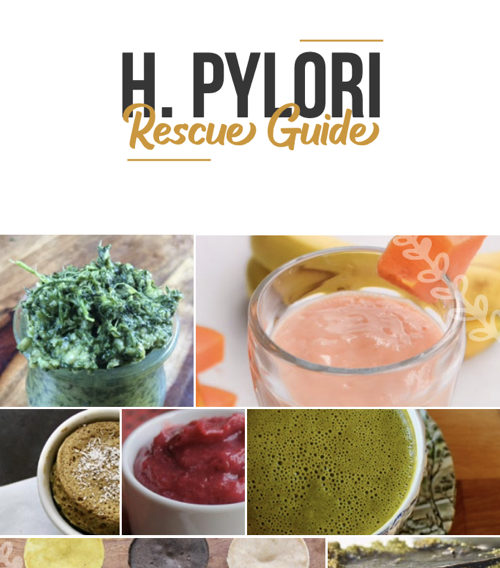H. pylori is often at the root cause of low stomach acid, poor digestion and microbial overgrowth. I see more of it than any other pathogen in my health coaching practice. I’ve developed experience on how to deal with stubborn cases.
H. Pylori is a very common. It’s a bacterial infection of the stomach that’s typically treated with antibiotics, but there’s another way. H. Pylori was only discovered in the 1980s.
For some people it causes zero symptoms. While for others it leads to low stomach acid, reflux, food sensitivities, anxiety, ulcers, constipation or diarrhea, fatigue, nutritional deficiencies and bacterial and yeast overgrowth (in the small and large intestine). Some tell tale signs that h. pylori is present are reflux, a heavy feeling in the belly after eating or gnawing pain when hungry.
H. Pylori is hard to test for, so there are many false negatives on standard medical tests and it’s becoming harder and harder to treat because of antibiotic resistance.
The GI Map is one of the best tests for detecting h. pylori and it also shows which antibiotics each individual is resistant to.
The standard medical treatment for h. pylori is triple therapy antibiotics and a stomach acid lowering agent (PPI). This method is only about 60 percent effective. And it can have devastating effects on the biome, if it is already disordered.
There are other ways to address h. pylori, without disrupting the biome and risking side effects. It can be even more effective if done right.
There is so much misinformation about h. pylori and how to address, and I love educating people on the right way. I have had h. pylori personally and know it can be a hidden root cause of many IBS symptoms, particularly diarrhea, but mine manifested as constipation.
The right way to address h. pylori
I wrote the H. pylori Rescue Guide to correct misunderstandings about h.pylori and help people make protocol mistakes that don’t work. After getting rid of this infection my clients have better digestion, tolerate more foods and feel a lot better. Identifying and eradicating this infection can be a game changer.
Below are excerpts from the book explaining how to get rid of a stubborn h. pylori infection that doesn’t budge with multiple eradication attempts.
If you do decide to go the antibiotics route, I suggest taking a GI Map first to determine the state of beneficial bacteria and antibiotics resistance. It can save you a lot of wasted effort and regret.
And always take saccharomyces boulardii (a yeast-based probiotic) before, during and after a course of antibiotics to minimize damage.
Six reasons you can’t get rid of h. pylori and what to do instead
These tips address these common blind spots and mistakes people make.
Reason 1: Vagus nerve and stress
H. Pylori does not directly get better or worse depending on diet. It gets better or worse depending on the state of the nervous system. Nervous system balance is determined by stress.
It is not easy to destress. But you can balance your nervous system by toning the vagus nerve. This nerve is the communication link between your gut and your brain. Toning the vagus nerve is also very calming to the body and good for lowering anxiety and stress.
Some ways of toning the vagus is deep belly breathing or vibrating the nerve through singing, gargling, gagging or laughing.
Practices that help tone the vagus nerve are yoga, chi gong or tai chi and acupuncture.
Hot and cold contrast showering or alternating cold hot exposure is also very stimulating for the vagus.
Lastly face to face contact, and feelings of connection and support are very supportive for the vagus nerve.
Reason 2: Low Sig A
Sig A is the marker that measures the immune function in the gut. If your Sig A is below 250, you need to support it in order to get rid of an infection.
Both herbs and antibiotics work in tandem with the immune system to eradicate h. pylori. If the immune system is struggling all the herbs or antibiotics in the world won’t work.
If SigA is below 150 you need to first support your immune system for a few weeks before starting a killing protocol. Sac B. and immunoglubulins are the best way to support Sig A. I wrote about this topic in depth here.
Reason 3: No biofilm buster
H. pylori, like other organisms in your biome, uses a biofilm to protect itself from attack from the immune system and killing herbs.
Biofilms are formed by the bacteria itself as a protective shield. It’s like building a fortress to protect yourself from an invading army. You have to break the biofilm down to get rid of all of the hidden h. pylori.
You can do that with several biofilm busters, such as NAC, boswelia and blackseed oil (but be careful with the last one as it can cause ulcers if taken on an empty stomach). You need to use biofilm busters in tandem with herbs or antibiotics for full efficacy and to get rid of all the h. pylori.
Reason 4: Protocol not long enough, dosage too low or not using the right brand of products
Many people don’t take enough of the right herbs for long enough to get rid of the infection. Mastic gum needs to be dosed at 3000 mg per day for 2 months straight. Matula tea should also be taken for 2 months.
A protocol that is too short in duration and too small in dose is a common reason people make little progress. Also, you need to get the mastic gum from Chios. Allergy Research brand contains this type of mastic gum.
Reason 5: Your partner may be reinfecting you
It is easy for couples to pass h pylori back and forth. If there is someone that you kiss and spend intimate time with you may want them to do the protocol with you so you don’t pass the infection back and forth. Even if someone doesn’t have symptoms they still may carry the infection.
Reason 6: Raising acidity in the stomach with coffee or HCL
H. pylori bacteria lower the acidity of stomach acid to help themselves survive. When you raise acidity in your stomach with hydrochloric acid supplements (HCL) or by drinking coffee, the bacteria burrows into the stomach lining where it can escape eradication. In the guide I give instructions on foods to use to paralyze or slow bacteria so it can’t escape.
It’s a good idea to avoid coffee and HCL supplements while addressing h. pylori.
These are the 6 most common mistakes I see people make. Hopefully, one or more of these modifications to your protocol could make all the difference.
Get more detailed info and recipes here.
Do antibiotics work for h. pylori?
The debate of whether to take antibiotics or do the natural protocol is a personal one. But before you make the decision it is important to understand the facts and the side effects.
Natural protocols may take longer (2 months vs. 2 weeks for antibiotics) but they will not do damage to the biome at all, they just address h. pylori. This makes a natural approach much lower risk.
Many people have come to me for support after a triple therapy antibiotic protocol for h. pylori, because it caused more problems than they originally had. Antibiotics can devastate the gut and some people have a hard time recovering from it.
Trying a natural protocol first makes sense because it can be equally as effective and will not cause more damage.
Mastic gum is well tolerated and doesn’t need a prescription. Matula tea is another good option if you prefer to sip tea rather than swallow capsules.


